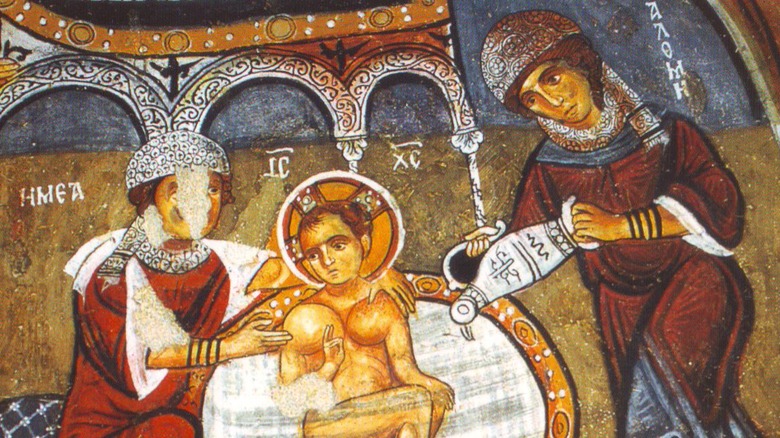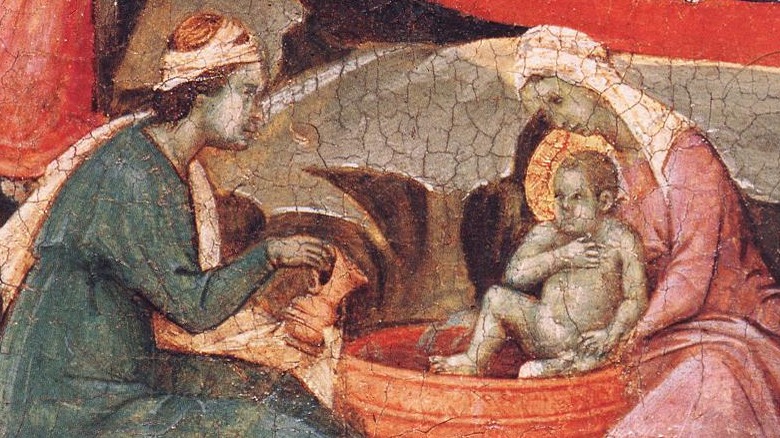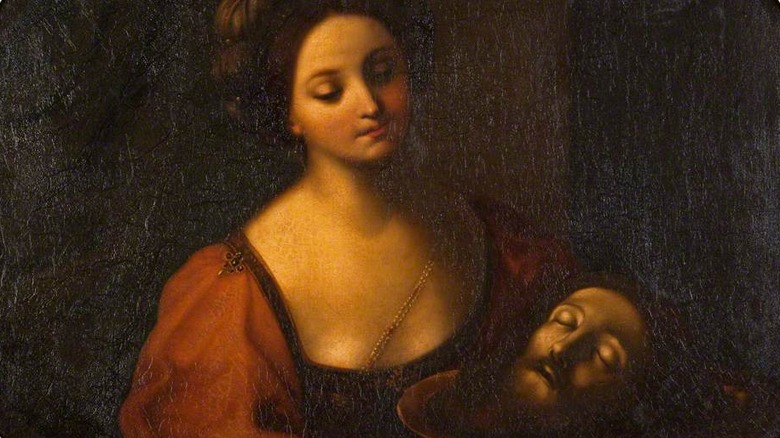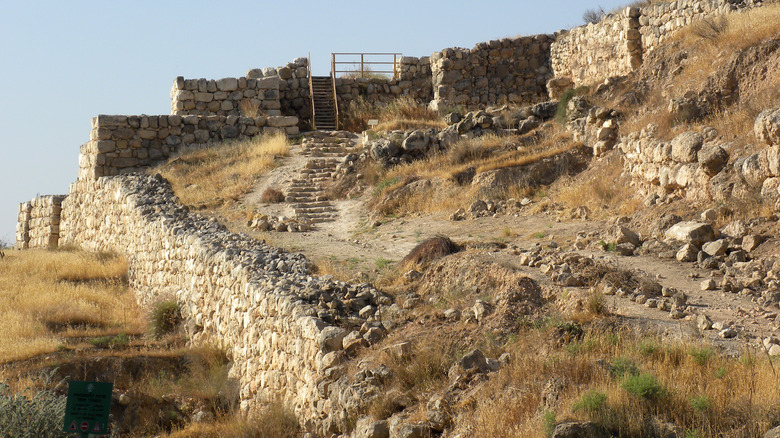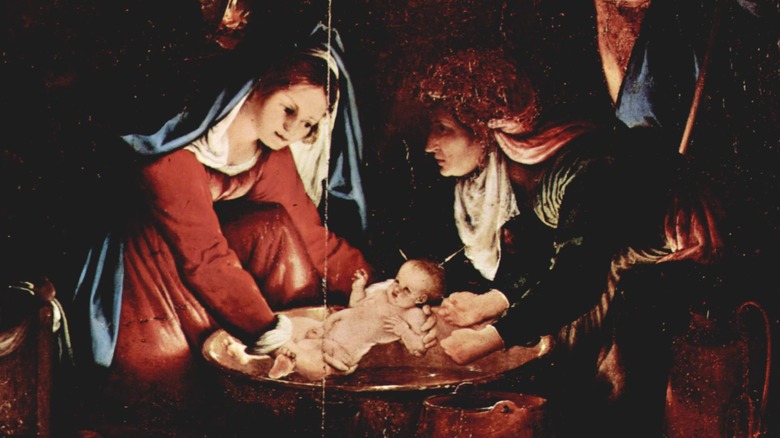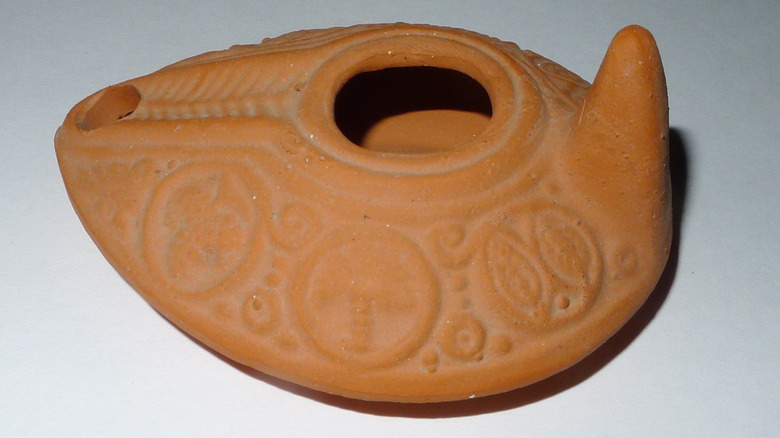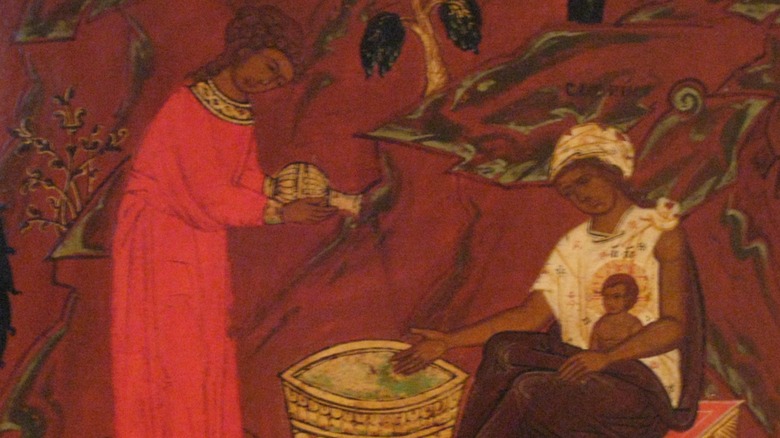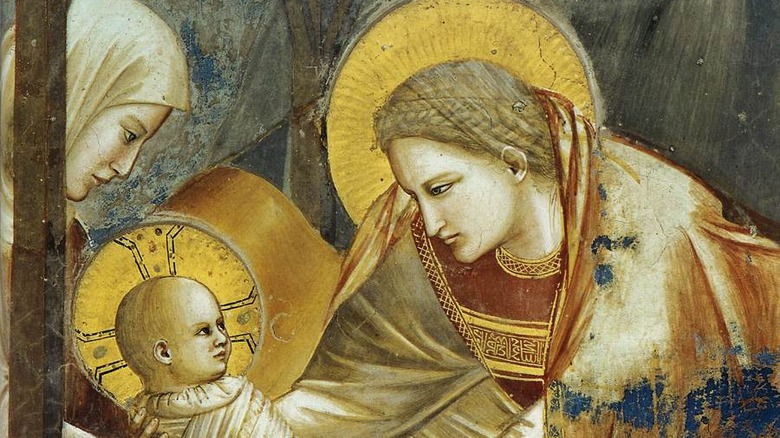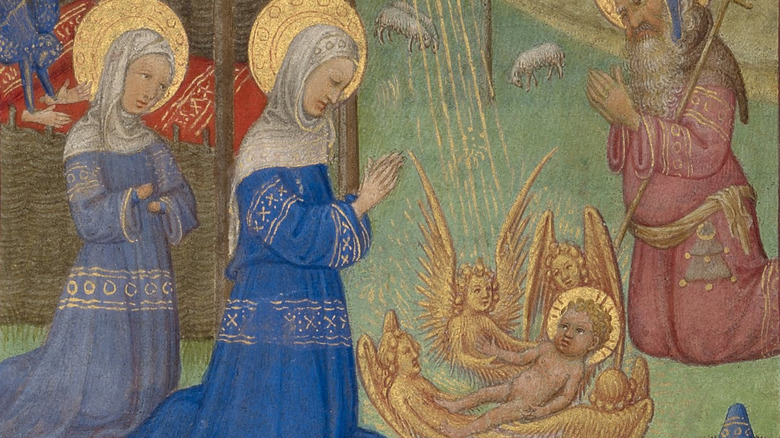The Fascinating History Of The Tomb Of Jesus' Midwife
The city of Jerusalem is full of historic sites of significance to Jews, Christians, Muslims, and non-religious history buffs alike, including the Church of the Holy Sepulchre, the Temple Mount, and Mount Zion, among dozens and dozens of others. These sites are significant to religious visitors in part because they at least claim to be the very places where monumental figures of the Bible such as King David, Saint Peter, and even Jesus himself did some of the things you definitely hear about in church or on "Veggie Tales."
But one site that as of the 2020s was being newly excavated just outside of Jerusalem is dedicated to a figure you most likely didn't learn about in Sunday school: Salome, a midwife who was present at the birth of Jesus and who was one of the first to proclaim the divinity of the newborn King of Kings. But while you may not be familiar with this somewhat obscure figure, medieval Christians definitely were, and her alleged burial place was once a popular pilgrimage site. So who was Salome, why do archeologists think they know where she was buried, and why would anyone want to look at her grave?
Who was Jesus' midwife?
Chances are good you didn't even know that Jesus had a midwife, and you almost certainly didn't know she had a name. The narrative of the Nativity of Jesus only appears in the Gospel of Luke, which simply says that Jesus was born, wrapped in cloth, and laid in a manger. The only people mentioned in Luke who are present besides Mary and Joseph are the shepherds and a mess of angels. Certainly not an OB-GYN or a midwife or a doula to aid in the delivery. That's all the Bible says, that's all that Linus recites at the end of "A Charlie Brown Christmas," so that's got to be all there is, right?
Well, before the Protestant Reformation asserted that the only writings bearing divine authority are the books of scripture, many Christians' understanding of the lives of major biblical figures came from traditions and legends outside the Bible. One of the most influential of these sources is a book called The Infancy Gospel of James, also known as the Protevangelion. This gives an expanded account of the birth and childhood of Mary as well as the Nativity, including a scene where Joseph goes looking for a midwife and time stands still. He returns with a midwife to the cave (not stable) where Joseph left Mary, only to see the cave fill with a blinding light and the Baby Jesus teleport from Mary's womb and into her arms, no midwife needed. So this is the midwife whose tomb was found, right? Well, no, actually.
Which midwife is which?
The Infancy Gospel of James continues, recording that the unnamed midwife that Joseph fetched is amazed at the miracle and goes to tell a friend and fellow midwife of hers named Salome all about the incredible teleporting baby she saw. Salome is skeptical of the miracle and refuses to believe that her friend has seen a virgin birth until she can examine Mary's undercarriage for herself. When she reaches under Mary's dress, her hand burns and withers as punishment for her lack of faith. Salome realizes what she's done wrong and prays to God for forgiveness. God sends an angel who tells her to touch the Baby Jesus in his manger-crib and she will be healed. She does and she is. The gospel continues from there, but that's essentially the end for Salome.
Despite the fact that the narrative of James says that Jesus was born without the help of any midwife whatsoever, the two midwives, Salome and the unnamed first midwife, are commonly depicted in art bathing or otherwise tending to the infant Jesus. Although some other texts and traditions apply various names to the other midwife, Salome is the one who has a consistent name throughout the tradition, so it's not hard to understand why she might be the more enduring figure in popular consciousness. After all, it's likely no one is going to write "a midwife whose name we don't know but who definitely gave Jesus a bath" on someone's tombstone.
Too many Salomes
That being said, there's not actually that much difference between having no name at all and being named Salome. It turns out that the name Salome was an incredibly popular name among Jewish women in the first century CE. "Salome" is the Greek form of a Hebrew name that could be spelled like Shlomit or Shulamit. It's derived from the well-known Hebrew word shalom, meaning peace, just like the name Solomon. There were a number of notable Jewish women from this time period with the name Salome, including Salome Alexandra, a queen of Judea from the first century BCE; Salome I, the sister of Herod the Great; and Salome II, the daughter of Herod the Great.
But Salome the midwife isn't even the only Salome tied to the life of Jesus. Probably the most famous is the daughter of Herodias who demanded John the Baptist's head on a platter, although she is never actually named in the Bible, and the name comes from the Jewish historian Josephus' accounts of the family of the Herodians. But the gospels do talk about a Salome who was at the crucifixion and one who was at the empty tomb, as well as one who was the mother of the apostles James and John, who might have been Mary's sister. It's unclear how many of these Salomes are distinct people; various traditions combine them in different ways. Some churches even teach that Salome the midwife is the Salome from the empty tomb: in that way, the same woman was one of the first to witness both Jesus' birth and his resurrection.
Where is Salome's tomb?
You can see why the discovery of the tomb of Salome would be a big deal. The actual, physical tomb that has been traditionally identified as that of Salome since the medieval period can be found in a cave near Tel Lachish National Park, about 30 miles southwest of Jerusalem. It's near the ancient city of Lachish, which appears several times throughout the Hebrew Bible, including being besieged by the Israelite leader Joshua during his conquest of Canaan, as well as being besieged and conquered by the Assyrians, as recorded in the Book of Kings. Kind of a rough legacy to leave behind, so you might understand why they might want to play up the midwife thing.
The tomb of Salome is part of a larger burial complex. Within the cave, there are various burial niches called kokhim carved out of the rock walls, as well as numerous ossuaries – essentially a receptacle or vault full of loose bones – in diverse states of disrepair. It's likely that it was on one of these ossuaries that medieval Christians found the name Salome written and thus attached to the cave the identification with the burial place of Jesus' midwife. Why Salome the midwife and not Salome the disciple or Salome, Jesus' aunt? Who knows. But whatever the reason, the site became a place of pilgrimage for Christians starting around the 5th century CE.
[Featured image by Wilson44691 via Wikimedia Commons | Cropped and scaled | CC BY-SA 3.0]
History of the cave
Before becoming a destination for traveling Christians, the tomb of Salome was almost certainly originally just a burial complex for a wealthy Jewish family from the late Second Temple period, meaning it was probably roughly contemporary with the life of Jesus. Evidence of this includes the style of burial itself, which reflects the Jewish customs of the time, as well as the decoration of the cave itself. When you hear the word "cave," it's pretty easy to just imagine a hole in a big rock with a dirt floor and maybe a sleeping bear in it, but this family tomb complex turns out to be pretty fancy. In addition to the numerous niches and ossuaries, there is also a forecourt spanning nearly 4,000 square feet covered with mosaic flooring.
Additionally, the entrance to the cave was lavishly decorated with various carvings that would have been symbolically significant to Jewish mourners: pomegranates, rosettes, and vases decorated with acanthus leaves. All of these are fairly typical of Jewish design at the time. A statement from the Israel Antiquities Authority says, "The family tomb attests that its owners were a family of high status in the Judean shefelah [lowlands] in the Second Temple period." One important signifier of the wealth of the family is the fact that similar tombs of the time would have had their forecourts simply carved out of the rock and not filled with elaborate masonry and tiling as the Salome Cave does.
[Featured image by Ian Scott via Wikimedia Commons | Cropped and scaled | CC BY-SA 3.0]
Becoming a Christian shrine
While the figure of Salome the midwife is not very familiar to modern Christians, especially those who are part of Western church traditions like Catholicism or Protestantism, she was well known to early Christians who weren't as concerned with modern ideas like the canonicity of books like the Infancy Gospel of James. Similarly, the common depiction of Salome and the other midwife in Orthodox depictions of the Nativity hints that the women were well-regarded in the Eastern church. One clear sign of the popularity of Salome is the use of her alleged tomb as a pilgrimage site for Christians in the early Middle Ages. Christians from all over the world would come to visit this cave once it had been identified as the resting place of Jesus' own midwife('s skeptical friend).
Archeological evidence suggests that the pilgrimage site was a fairly popular one well into the early Muslim period, continuing as a shrine until at least the 9th century. Recent excavations have uncovered clay oil lamps that date to the 8th and 9th centuries which would have been used by pilgrims, either to light their way in the dark burial niches or else as part of their veneration of the shrine, similar to lighting candles at someone's grave. Archaeologists have even uncovered a row of shop stalls surrounding the complex's forecourt where merchants would have rented or sold these lamps to pilgrims for this purpose. In the shop area, hundreds of lamps both whole and broken have been uncovered.
Rediscovering Salome's cave
The idea that the veneration of Salome at her tomb continued into the Muslim era is supported by the fact that the interior walls of the cave are covered in inscriptions and engravings by visitors across the centuries. Some of these dozens of carvings are written in Greek and clearly from Christian pilgrims, but more than a few are written in Syriac or Arabic. But after the 9th century, there is very little known about what happened to the cave, though presumably, it fell into disuse as a shrine as tensions between Christians and Muslims during the Crusades would have made pilgrimages more difficult.
The tomb was essentially lost and forgotten until 1982 when looters searching for antiquities to sell on the black market broke into the tomb-turned-shrine. These grave robbers drew the attention of legitimate archeologists, including Prof. Amos Kloner of Israel's Antiquities Department, who began a series of excavations that have continued to this day. Prof. Kloner's excavation revealed the burial niches and ossuaries, which were to be expected in such a cave from such a time period, but the thing that surprised the professor was the presence of Christian crosses in a Jewish tomb as well as the architectural conversion of the place into a chapel or shrine. Though the ossuary that probably inspired the veneration of the site was gone, the inscriptions on the walls from pilgrims were the giveaway that this cave was believed to be the shrine of Salome, the midwife of Jesus.
A new dig
While the tomb as a whole was rediscovered in the 1980s and archeological work on the site continued in the intervening decades, it has only been in more recent years that archeologists have begun to uncover the spacious forecourt of the burial complex. These more recent excavations by the Israel Antiquities Authority come as part of a plan to open up this site to the public as part of a larger project emphasizing Jewish cultural heritage throughout the Judean lowlands that include sites like Tel Lachish, where the Salome Cave is located.
The entrance courtyard encompasses some 350 square meters or roughly 3,767 square feet. This is the area that is tiled with mosaic flooring and surrounded by walls made from ashlar stone masonry. Ashlar masonry is made from finely hewn stone formed into smooth and regularly shaped rectangular bricks that fit together tightly rather than irregularly shaped stones that are fit together using mortar. These unusually nice elements contribute to the idea that this cave was originally the resting place for a particularly wealthy family as well as a popular chapel and shrine. This is the area that also includes much of the intricate carving and design work and the numerous impromptu engravings made by pilgrims and other visitors that helped identify the site as belonging to Salome.
[Featured image by Петро Родим'юк via Wikimedia Commons | Cropped and scaled | CC BY 4.0]
What they found inside
It has been with the renewed excavations that some of the most interesting (and potentially valuable) artifacts have been uncovered. In addition to the courtyard's mosaic flooring and elaborate walls, the entrance to the cave — decorated, as mentioned before, with intricate carvings of various floral designs in the Jewish style of the time — also features tall arches and the market stalls where the clay lamps were found. These dozens of lamps found within this area are, like the entrance walls, elaborately ornamented with common artistic motifs such as pomegranates and more geometric elements.
Perhaps even more interesting is the abundant graffiti found throughout the cave. In addition to the numerous crosses that helped identify the cave as a Christian site, numerous pilgrims carved their own names into the wall as something of a guestbook that's less respectful of history. But most importantly, the name Salome and the word midwife appear over and over. Perhaps the most notable inscription reads "Zacharia Ben Kerelis, dedicated to the Holy Salome." The archeologists of the IAA have suggested that the prominence of this dedication suggests that Zacharia Ben Kerelis was a Jewish patron of the site and may have used his own personal wealth in the development of the shrine and courtyard.
One more surprising discovery for the IAA has been modern-day candles, icons, and other elements of worship, which indicate that the shrine is still being visited by pilgrims, even if it's technically illegal until the site is opened to the public.
Opening to the public
As of this writing, the site of the Salome Cave is still being excavated and is therefore closed to public exploration. However, a major part of the point of this new dig is to prepare the site to become a place where general audiences can come and enjoy it. The restoration of the Salome Cave is part of a larger project by the Israel Antiquities Authority, the Ministry for Jerusalem and Heritage, and the Jewish National Fund called the Judean Kings' Trail Project. This 60-mile trail, stretching from Beersheba to Beit Guvrin, crosses through the Judean lowlands and covers numerous sites built or otherwise significant in the times of the Bible, the Second Temple period, or the development of the Talmud. One of the major motivations behind the Judean Kings' Trail Project is to show the cultural significance of places in forested places such as Lachish and to draw tourists away from just the cities and into more open areas.
With the Salome Cave specifically, the IAA knows there will be interest due to it being a sacred Christian site. Their current efforts include seeking out ways to protect the numerous inscriptions carved into the wall while still making them accessible to tourists. They likewise hope that once the site is officially opened to the public, the modern-day pilgrims to the site will no longer feel it necessary to break in and everyone will be able to safely check out this cave that was once so important to medieval Christians.
Is it real, though?
But while the Salome Cave was an important shrine for pilgrims in the Byzantine Era, you might well wonder how important it will be to people now. What, after all, is the likelihood that this site is the authentic burial place of a woman who once bathed the infant Jesus? Well, if you don't put any stock in early extracanonical gospels — either because you only believe in the validity of the biblical canon or because you don't believe in any kind of Bible at all — chances are pretty low that you put much stock in the authenticity of this cave. Additionally, the fact that the main connection to Salome the midwife in the first place is that there was probably at one point a box full of bones with her name on it — a name which has already been established as very popular at this period of history — might add to the skepticism.
And you wouldn't be alone there. Most Protestants don't give much credence to traditions from outside the Protestant canon, and many Catholics — who are generally much more open to tradition as a source of teaching — are also hesitant to fully buy into the narrative from the Infancy Gospel of James, or even the idea that Jesus had a midwife at all. No less an authority than St. Jerome himself said, "No midwife assisted at his birth; no women's officiousness intervened." But clearly, Israeli tourism is hoping you believe in Salome and counting on you being interested in visiting her once-popular shrine.
